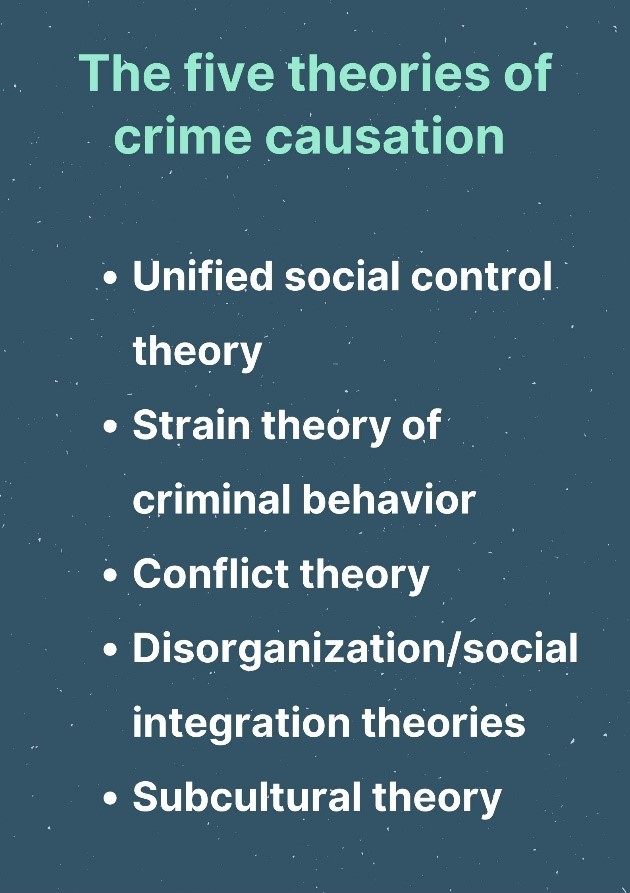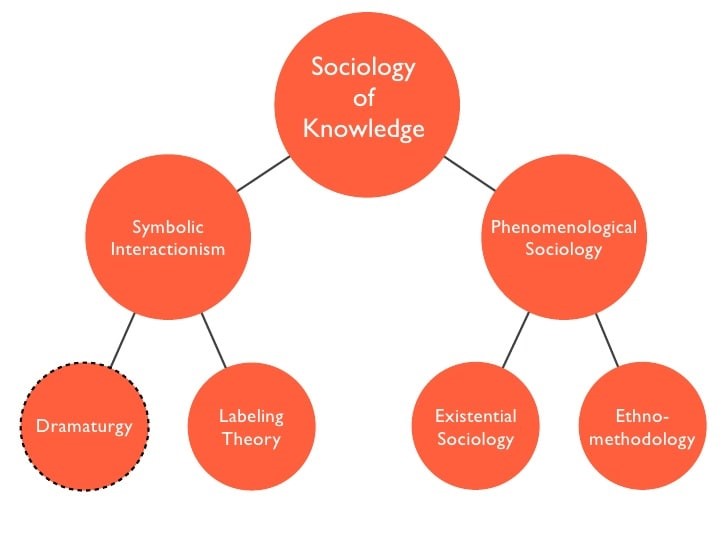Major Theories of Crime Causation
Introduction
Theories of Crime Causation are varied lot, and the ways in which criminologists attempt to understand crime have become increasingly diverse. Whether it’s biological or environmental factors, culture or socialization, criminals do not usually fit into one category only. This post will explore some major theories that try to explain why people commit crimes.
It is important for us to understand these theories because they can be applied in various contexts. They can help to better understand what causes individuals to turn to criminal behaviour. For example, if we know that an individual has been exposed to high levels of lead during their youth and this exposure led them down a path of criminal activity then we may want to examine how we can mitigate those effects going forward by removing the lead.
In case you wish to skip this article due to reasons such as a busy schedule or otherwise, our ivy league writers are ready to cover you by acing that sociology assignment for you at an affordable fee. All you have to do is place an order with us.
What Are the Five Theories of Crime Causation?
The five theories of crime causation are:
- Unified social control theory
- Strain theory of criminal behaviour
- Conflict theory
- Disorganization/social integration theories
- Subcultural theories.
Unified Social Control Theory
Unified social control is a macro-level sociological theory that emerged in the 1970s. It is one of the most popular theories of crime causation today, especially among criminologists. This theory attempts to analyze and explain both property and violent crime.
The theory was developed by Travis Hirschi (1969) and has gained support in subsequent research by other scholars.
The main premise of unified social control is that a cohesive social group is important for maintaining social order. When a youth joins a delinquent gang, the connections to the larger community are weakened, and so is their attachment to conventional society.
The theory states that if people feel connected to their community, they will be less likely to commit crimes because they have more attachments and commitments. If one feels alienated from the community, they are more likely to commit crime because they will have fewer attachments and commitments.
According to the unified social control theory, several elements contribute to an individual feeling connected to their community: having friends, participating in activities, developing values, achieving goals, and being involved with the family.
When one of these “bonds” is weakened (or nonexistent), the theory suggests that a person is more likely to commit a crime.
Strain Theory of Criminal Behavior
Strain theory of criminal behaviour is a sociological explanation for crime causation. The theory was articulated by Robert Agnew in 1988 and built on the theories of Emile Durkheim, Edwin Sutherland, Donald Cressey, Travis Hirschi and others.
Strain-based explanations suggest that people are more likely to commit a crime when they feel they have been unfairly dealt with. These feelings can be described as strains.
Strain-based explanations for crime causation were first articulated in the early 1900s by the Chicago School of Sociology and its founder, Robert E. Park (1864-1944). The term “social disorganization” describes how people living in urban environments face greater challenges when trying to follow societal norms and values.
Simple strain theorists suggest that people commit crimes because they feel the “stresses of life” have been too much to handle. A more complex strain theory suggests that a person may turn to crime due to unjust treatment or unequal opportunities.
It is important not to confuse strain theory with social disorganization theory or subcultural theories. The main difference is that strain-based explanations (unlike the other two theories) point to internal factors as causes of delinquency and crime.
Conflict Theory
One of the most well-known theories of crime causation is conflict theory, which was developed by sociologists Karl Marx and Max Weber. Marx’s economic analyses focused on social inequality and exploitation.
In his approach to understanding society, wealth leads to power, and power leads to more wealth. In contrast, Weber emphasized political, cultural and religious influences, which resulted in social inequality.
In his approach to understanding society, wealth leads to power (in addition to political, cultural and religious influences).
The conflict theory of crime is based on a “zero-sum” view of the world: when one group gains something (wealth/power), it results in another group’s loss.
In conflict theory, poverty does not cause criminal behaviour; rather, criminality is caused by the types of healthy opportunities available to individuals in society (i.e., legitimate means).
Social Disorganization Theory of Criminology
Edwin Sutherland was one of the first researchers who focused on the relationship between crime and social structures in his studies of white-collar crime. Sutherland argued that both poverty and subcultures are social disorganization factors in society, which leads to crime and delinquency.
Subcultural Theories
Subcultural theories have several similarities with personality and personality trait theories. For example, subcultural theories suggest that people who are involved in deviant cultures (the “criminal subculture”) will most likely commit a crime; personality theorists suggest the same as well because people with similar personality traits often share common interests or behaviours.
Over time, personality trait theories have become less popular than personality factors in understanding personality and personality disorders (such as criminality). This does not mean that personality traits are not important to the study of criminology.
Travis Hirschi first proposed the theory in 1969; he suggested that people commit crimes when they go through an identity crisis because there is no attachment to mainstream society. This theory was later referred to as “Hirschi’s control theory”.
What Are the Three Major Theories of Criminal Behavior?
Over the years, sociologists and other researchers have proposed three different or similar Theories of Criminal Behavior. The theories are:
- The Merton Thesis
- The Social Learning Theory
- The Differential Association theory
Ralph H. Merton (1910-2003) was a British sociologist who is widely regarded as one of the founders of modern sociology, alongside Emile Durkheim and Karl Marx.
The Merton thesis in criminology states that an individual’s criminal behaviour is a product of four factors: 1) Strain which may be psychological or external 2) The availability of rewards for crime 3) The absence of sanctions against crime 4) The characteristics of the individual. The social learning theory says that people learn to commit crimes through their social interactions and associations. The differential association theory states that an individual commits a crime as a result of their exposure to criminal conduct.
What Are the 3 Theories of Deviance?
There are three major theories of deviance: strain theories, labelling theories, and the conflict theories
Strain theory posits that people join gangs because they feel alienated from conventional society. This means that even when a person is not directly involved in criminal activity, they are still affected by the strain of crime and gangs.
The labelling theory shows how a person’s identity changes when they are labelled by society. The conflict theory argues that crime is rooted in the conflicts between different groups and classes of people. The three theories of deviance focus on different aspects of deviant behaviour.
What Are the 3 Theories of Crime?
The three main theories of crime are; the classical theories, the social disorganization theories, and the control theories.
Classical theories or the positivist theories of crime emphasize biological factors and hereditary criminality, which criminologists held during the enlightenment. The social disorganization theories in criminology refer to crime as a product of anomie, meaning dysfunctional aspects of society.
The control theories in criminology explain crime as a result of the breakdown of social control. The three Theories of Crime focus on different aspects and different factors of crime.
Who is the Father of Criminology?
The father of criminology is Cesare Beccaria (1738-1794), an Italian criminologist, jurist, and philosopher. Some of his remarkable works are on crimes and punishments, crime prevention, and the crime district of Milan.
What is/Are the Main Purpose(s) of Criminology?
Criminology is the study of crime and crime control in society, with an emphasis on crime causation.
There are also other purposes of criminology: to explain crime distribution in a certain social context to describe the variance in crime characteristics across social contexts review criminal law and crime control policy
What Are the 2 Major Schools of Criminology?
The two schools of criminology are the Classical School and the Modern School.
Cesare Beccaria and Jeremy Bentham formed the Classical School of criminology. The main focus in this school is crime prevention through punishment. Some prominent members of the classical school include John Locke, Adam Smith, Jeremy Bentham, Cesare Beccaria, David Hume and Thomas Hobbes.
The Modern School of crime was also formed by the Classical school. In this school, crime is seen as a product of social conditions like poverty and inequality
You may be interested in Victimology
What are the 4 Main Problems Criminologists Study?
The four main problems criminologists study are crime rates, crime patterns, crime distribution and crime control. Crime Rates refer to the frequency of crime within a specified period.
It is usually expressed as crime incidence per 1000 or 100,000 persons. Crime Patterns refer to the geographic location of crime incidents in a community or region.
Crime Distribution refers to how crime is distributed across a community. Crime Control refers to crime prevention and crime detection methods
What Are the 2 Main Goals of Criminology?
The two main goals of criminology are to explain criminal behaviour by identifying risk factors that increase crime rates and to describe crime in society by examining crime patterns, crime distribution, crime control and crime rates.
What Are Behavioral Theories?
Behavioural theories are crime theories that examine crime as the behaviour of individuals, groups and societies. This school of criminology was formed by Gabriel Tarde, a French sociologist who said crime is a result of social forces like imitation or conflict.
What Are Macro-Level Theories in Criminology?
Macro-level theories in criminology are crime theories that examine crime and crime control policies from a broad social perspective. This school of crime theory was formed by Anomie theorists (Cesare Beccaria, Emile Durkheim).
Theories include structural functionalism, symbolic interactionist, social disorganization theory, control theories, differential association theory, and Neo-Marxist theories
What is a Crime Prevention Strategy?
A crime prevention strategy is an organized crime control plan aimed at preventing a crime or crime of a particular type. There are three basic crime prevention strategies: Natural Environment Control, Motivational Control, and Institutional level.
Who is the Ideal Victim?
The ideal victim is the victim who will most likely be chosen by a criminal, depending on the type of crime and location. For example, in New York City, mugging perpetrators focus on women targets because they are more likely to cooperate with muggers than men.
The focus of the mugging is on a white female in Manhattan between 25-40 years old. The focus of rape is on teenage girls with black hair and teenagers with blond hair in Washington DC. In general, youth, age and gender are important factors that crime perpetrators focus on as victims.
You may be interested in the Subculture Theories
Are Criminals Born or Made?
According to the Classical School of criminology, criminals are born. The idea that personality traits such as personality disorders or abnormal personality characteristics lead to criminal behaviour was first introduced by Cesare Beccaria in his book On Crimes and Punishments. According to the Modern School of Criminology, crime is an acquired behaviour.
A social environment influences personality traits and personality disorders, while personality characteristics can change over time. This school of criminology was formed by the Classical School of criminology and the Positivist School of criminology (Gabriel Tarde).
What Are the 6 Major Areas of Criminology?
The six major areas of criminology are juvenile delinquency, white-collar crime, environmental criminology, forensic psychology, drug use and abuse, and victims of criminal behaviour. The study of juvenile delinquency looks at the crime committed by children and adolescents.
White-collar crime is a term coined by Edwin Sutherland in 1939 to describe crimes such as fraud, corruption, embezzlement, computer crimes and scams.
Environmental criminology is a branch of criminology that studies the relationship between physical settings and crime. Forensic psychology looks at the psychological aspects of crime and criminal behaviour. Drug use, abuse and control look at different types of drugs and their effects on society.
What is Theoretical Criminology?
Theoretical criminology is a sub-set of criminology. In this area, the researcher studies theoretical and analytical models used to explain and predict crime events. This branch of criminology is also known as classical criminology or Positivist criminology. The Classical School of Criminology includes Classical Positivist Criminology, Anomie Theory and Strain Theory.
What Are 3 Major Components of Juvenile Delinquency?
The three major components of juvenile delinquency are personality, social bonds, and life events. Personality can be an aspect that causes delinquent behaviour.
Social bonds refer to family and community relationships, such as being a part of a gang or some other negative social group.
Life events can also contribute to delinquent behaviour, such as moving or having no friends at school.
What Are the Essential Elements of a Crime?
The basic elements of a crime are crime time, place, victim, and offender. For there to be a crime in the first place, three essential elements have to come together; the criminal act has to happen at a certain time in a specific place with a specific victim (and usually with an object as well), this is known as the victim.
Example: A criminal breaks into someone’s home with a crowbar and steals valuable items.
This is an example of a generic crime. In this circumstance, the criminal act is to break into a home. It breaks down even further into: the offender intends to commit the crime by breaking. With intent, he has thought about it beforehand; he uses force or coercion (in this instance, breaking into someone’s home to commit a crime is considered force); and uses an object (breaking into someone’s home with a crowbar).
You may be interested in Sociology Paradigms
What Are the Different Types of Offenders?
Criminals can be classified in many different ways, such as personality traits or aptitudes. The three major types of offenders are habitual offenders, personality offenders, and anti-social personalities.
The personality traits of the personality offenders are superficial charm, pathological lying, conning/manipulative, lack of remorse or guilt, parasitic lifestyle (will often take advantage or manipulate others), no regard for the safety of self or others, and continuous violation of the rights of others.
Anti-social personality presents as a personality disorder, meaning the personality pattern is not part of the individual, and it cannot be changed. Anti-social personality focuses on violating social norms, has poor behavioural control, blames others for their problems, and doesn’t have a good work ethic.
Habitual offenders are commonly referred to as career criminals; this personality type usually displays criminal behaviour in childhood and then continues their criminal behaviour into adulthood.
These personality types can be found in any personality and gender. They differ from offender to offender, but all have one thing in common: personality traits that cause them to commit crimes.
What Are the Components of Victimization?
The three major components of victimization are personality factors, life experiences, and situational factors. Personality can be an aspect that causes one to become a victim.
Personality traits such as being gullible or naive can lead to someone becoming a victim of crime. Life experiences are part of personality and include events in life that affect personalities, such as abuse in childhood or some traumatic event.
Situational factors include situational crime prevention (burglar alarm, security systems); reducing the chance of becoming a victim involves avoiding certain situations.
What Are the 7 Elements of a Crime?
The seven elements of a crime include criminal act, criminal intent, victim, force and injury (resulting from force), perpetrator/ offender, location, and object. The term criminal act describes what the crime consists of, such as assault or robbery.
Criminal intent refers to the psychological state where a person intends to commit an illegal act. A victim is anyone who is directly or indirectly harmed by a crime, such as a witness.
Use of force and injury refers to the use of physical violence or threat of physical violence; there must be an injury for the act to be considered a crime.
The perpetrator/offender is anyone who commits a crime, while the location is where the criminal act occurred, and the object is the item that was used in the crime (gun, knife).
You may also be interested in the Thomas Theorem
Conclusion
Crime has been a major problem for society since the beginning of time. Sociologists have tried to find socio-economic, psychological, and sociological explanations for why people commit crimes. With each theorist, there is some truth that they can offer up as an explanation but no one theory seems to be able to account for all crime in society.
This article has been put together to illustrate what is considered a crime and the different components of victimization and offending.
As part of society, it is important that we understand these issues and how they relate to us. In case you need help with a sociology assignment, our professional writers for hire are ready to help!







